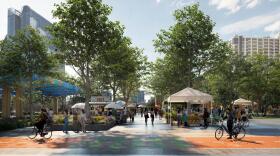For 50 years, the upper decks of I-35 have loomed over Central Austin and lifted traffic noise high into the air. With those elevated lanes slated to come down starting next year, people who live alongside them must decide by today if they want a new concrete barrier in their backyards.
At 21-feet tall and nearly half-a-mile long, a proposed noise wall in the Cherrywood neighborhood would stretch from 30th Street to 38 1/2 Street with gaps for cross streets. The barrier is meant to block some of the sound from the largest-ever expansion of the highway, which has run through Central Austin since 1962.

"I think a 21-foot-wall is really extreme," said PJ Raval, a filmmaker and UT associate professor. "That's going to block the sun."
The concrete wall would be built just 3 feet from Raval's backyard. His home on Robinson Avenue is among a line of midcentury houses that now sit on the edge of the interstate's widened footprint. Businesses that once served as a buffer between homes and the highway have been torn down to make space for the extra lanes.
"I understand the need for it, but where is the compromise?" Raval said.

The Cherrywood wall would be the largest of eight noise barriers proposed as part of the between Ben White Boulevard and U.S. 290 East. TxDOT is still considering a possible noise wall on the other side of the upper decks, at Aura Thirty2 Apartments.
I-35 noise walls were approved next to the Motel 6 at Royal Hill Drive in South Austin and at the just north of Lady Bird Lake. But they were rejected at the Grace Woods Apartments north of Woodward Street and at Berkshire Riverview Apartments north of Riverside Drive. All four were proposed on the east side of the highway.
In Cherrywood, the sound barrier would reduce traffic noise at more than 60 homes by at least 5 decibels, which is enough to be significantly quieter. TxDOT said some homes would see a reduction of 7 decibels or more.
Without the barrier, the highway expansion would expose Cherrywood to noise levels similar to what they are now. Even with more traffic, the main lanes will be sunk up to 60 feet below ground level, creating an open canyon that will contain some of the sound.
But those noise levels would still average 70 decibels, about the volume of a vacuum cleaner, which exceeds federal limits that weren't in effect when the upper decks were built.
The Texas Department of Transportation (TxDOT) is following its standard practice of offering residents an all-or-nothing vote on the noise wall with only one design choice: a textured or nontextured surface.

"In our neighborhood, we're a little upset that they came to us with this option or nothing," Greg Henny said. The Robinson Avenue resident is not allowed to vote because TxDOT calculated the wall would cut noise at his house by slightly less than 5 decibels, the minimum required to have a say.
"What would a 15-foot sound wall provide? What would a sound wall with different materials provide?" Henny said.

require noise barriers cut at least 5 decibels per household and stay under a set cost. The encourages the use of concrete: It's durable and less expensive than alternatives such as plexiglass, which is common in some European and Asian countries and has even been used in U.S. cities, including Boston and Minneapolis.
But TxDOT is sticking with concrete.
"All of our noise barriers are concrete. That's just what we do," said Scott Ford, an environmental supervisor for TxDOT's Austin District. He said the 21-foot height was chosen after TxDOT held public meetings in Cherrywood and heard concerns about existing noise levels.
"We picked a height that would maximize the benefit for the Cherrywood neighborhood based on that public input," Ford said.
Some residents are OK with that.
"I think 21 feet is little high, but I think we should go forward with it rather than not even do it at all," said David Martinez, who also lives on Robinson.
"Look at this fence," he said, pointing to his back yard. "It's a little janky. That's not going to provide any protection from the sound or even just people walking by or a car plowing through. I think the positives outweigh the negatives."
TxDOT will wait to receive any mail-in ballots and announce the results on the Cherrywood noise wall in the coming weeks.







